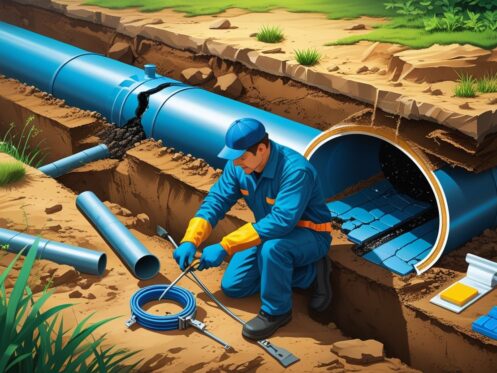Septic pipe issues can lead to significant headaches for homeowners. Whether it’s a crack, blockage, or total failure, timely repairs are crucial in preventing further damage to your property. Understanding the basics of septic pipe repair can save you time and money while maintaining the integrity of your plumbing system.
If you notice signs such as slow drainage or unpleasant odors, addressing these problems quickly can prevent more extensive repairs down the line. Solutions range from minor patching to complete pipe replacement, depending on the severity of the damage. For residents in Anaheim, Splash Plumbing offers expertise in resolving septic pipe issues effectively and efficiently.
With nearly two decades of experience in the plumbing industry, Splash Plumbing provides reliable repair services. Trust in a company that values customer care and satisfaction as much as efficiency in service. Don’t let a broken septic pipe disrupt your life—take action today!
Understanding Septic Pipe Repair
Septic pipe repair is essential for maintaining the functionality of your septic system. Understanding how septic systems and pipes operate, as well as the common causes of damage, can help you make informed decisions regarding repairs.
What Is Septic Pipe Repair?
Septic pipe repair involves fixing or replacing damaged pipes in a septic system to ensure effective waste management. This can include both underground piping that connects your home to the septic tank and pipes leading from the tank to the drain field. Repair methods often depend on the type of pipe material, which can include PVC, metal, or concrete. Techniques may involve sealing cracks, replacing broken sections, or installing entirely new piping. Homeowners with a broken septic pipe often experience slow drains or unpleasant odors, indicating a need for immediate attention. Engaging a professional service, like Splash Plumbing, can ensure your repair is executed correctly and efficiently.
How Septic Systems and Pipes Work
A septic system is a self-contained underground sewage treatment system. It consists of a septic tank that collects wastewater and a drain field that disperses treated effluent into the soil. When you flush a toilet or drain water, your septic pipe transports waste to the septic tank. The tank separates solids from liquids, allowing anaerobic bacteria to break down waste materials. The liquid effluent then flows through outlets into the drain field, where further treatment occurs. Proper functioning of the pipes is crucial; any blockage or damage can disrupt the entire system and may lead to costly repairs or health hazards. Regular inspections are vital to prevent major issues.
Common Causes of Septic Pipe Damage
Several factors contribute to septic pipe damage. Tree roots are a leading cause, as they can penetrate and disrupt underground pipes. Ground shifting due to heavy rain or seismic activity can also affect pipe integrity. Additionally, improper installation or poor-quality materials can lead to premature failure. Clogs from non-biodegradable items, grease, or excessive waste can exacerbate the problem, causing backups and overflows. To prevent these issues, regularly inspect your septic system and avoid flushing harsh chemicals or non-flushable items. Identifying the causes early can save you from extensive repairs. For professional help, consider reaching out to Splash Plumbing, particularly if you live in the Anaheim area.
Diagnosing Septic Pipe Problems
Identifying septic pipe issues is crucial for maintaining a healthy plumbing system. Symptoms can range from unpleasant odors to visible leaks. Understanding these signs and using the proper diagnostic tools can help address the problem efficiently.
Signs of Septic Pipe Issues
You may notice several indicators suggesting septic pipe problems. Common symptoms include:
- Gurgling Noises: Unusual sounds from drains can indicate air trapped in the pipes, signaling a blockage.
- Slow Drains: If fixtures drain slowly, it may point to clogs in the pipes leading to the septic tank.
- Foul Odors: A persistent sewer smell around your property may indicate a leak or backup in the septic system.
- Soggy Areas: Patches of wet soil in your yard could suggest a leak in the septic pipes or a failing drain field.
Timely recognition of these symptoms can prevent further damage and costly repairs. If you suspect problems, consult a professional like Splash Plumbing for an accurate diagnosis.
Camera and Video Inspection
One of the most effective methods for diagnosing septic system issues is using camera and video inspection. This technique allows a plumber to visually assess the condition of your septic pipes without invasive digging.
- Real-time visuals: A video camera is inserted into the pipes, revealing blockages, cracks, or tree root infiltration.
- Immediate feedback: This method provides instant information about the plumbing’s state, helping to pinpoint exact problems.
- Cost-effective: By locating issues quickly, this method can save you on extensive excavation and repair costs.
Regular video inspections can help monitor your system’s health and address potential issues early on.
Clogged Drain Diagnosis
Clogs can develop in various areas of your plumbing system, especially in the septic pipes. Diagnosing clogs involves several steps:
- Identifying Symptoms: Pay attention to signs like slow drains, gurgling noises, and foul odors. These often point to blockages.
- Using Tools: A plumber may employ augers or hydro-jetting to clear blockages without damaging the pipes.
- Professional Assessment: If DIY methods fail, professional assessment and repair are necessary to prevent sewage backups.
For residents in Anaheim, CA, Splash Plumbing provides expert services to help with clogged drains effectively. Timely action can save you from more extensive and costly repairs.
Repair Solutions for Septic Pipes
Septic pipe repairs can involve various methods depending on the damage type and location. Understanding the options available can help you make informed decisions about whether to opt for professional services or to take a DIY approach.
Professional vs. DIY Septic Pipe Repair
Hiring a professional plumber can save you time and ensure correct repairs. Experts have the necessary tools and experience to handle complex issues effectively. They can provide options such as trenchless sewer line repair, which minimizes disruption to your yard.
On the other hand, DIY repairs can be suitable for minor issues. With the right materials like epoxy or pipe sealant, you can seal leaks in PVC or metal pipes. However, you should assess your plumbing skills before undertaking repairs, as mistakes can lead to larger problems.
If you’re uncertain, contact Splash Plumbing for professional assessment and assistance with septic pipe repair.
Trenchless Repair and Pipe Lining
Trenchless technology allows for repairs with minimal digging, preserving your yard’s landscape. This method involves inserting a resin-saturated liner into the damaged pipe, which hardens to form a new pipe within the old one. Pipe lining is effective for fixing cracks and reinforcing weak areas.
This approach reduces labor costs and time, making it a popular choice among homeowners. It’s particularly beneficial for concrete and clay sewer pipes. If you’ve experienced recurring backups or leaks, trenchless repair might be the ideal solution.
Splash Plumbing can provide expert trenchless sewer line repair services tailored to your specific needs.
Traditional Repair Methods
For more severe damage, traditional repair methods may be necessary. This often involves excavation to access the pipe directly. Once accessed, options such as replacing damaged sections or repairing concrete pipes with mortar are executed.
If your septic system uses clay pipes, you may need a specialized repair method, such as splicing in PVC using rubber couplings. Identifying when to replace versus repair is crucial, and a professional evaluation can guide this decision.
Always consider the longevity and condition of your septic system when selecting a repair method.
Septic Pipe Maintenance and Prevention
Maintaining your septic pipes is crucial for the longevity of your system. Regular checks and preventive measures can save you from costly repairs. Below are key practices to ensure your septic pipes function optimally.
Routine Maintenance Practices
Regular maintenance of your septic system can prevent major issues. Schedule routine inspections at least once a year. During these inspections, the septic tank should be pumped to remove sludge build-up. This is essential to avoid clogs in the waste line that could disrupt your system.
You should also monitor what goes down your drains. Avoid flushing items like wipes, grease, and chemicals, as they can damage the septic tank baffle and disrupt operations. If you have a washing machine, make sure to distribute laundry loads to prevent overloading the system. Consistent care leads to a healthier septic drain field and reduces repair costs.
Preventing Future Septic Pipe Issues
To prevent future problems, consider your landscaping. Tree roots can infiltrate pipes, causing significant damage. Plant trees away from septic systems, ideally at least 20 feet apart, to avoid invasive roots.
Be cautious with chemicals you use around the house. Harsh chemicals can kill beneficial bacteria in your septic system, leading to waste breakdown issues. Instead, opt for septic-safe products. Regularly flushing your system with eco-friendly additives can help maintain bacterial balance and promote efficient waste decomposition.
Dealing With Tree Roots and Blockages
Tree roots often pose one of the biggest threats to your septic pipes. When roots invade, they can break pipes, leading to expensive repairs. If you suspect root intrusion, consult a professional plumber like Splash Plumbing to assess the situation.
They can use specialized equipment to mitigate root issues without damaging the surrounding environment. Additionally, installing root barriers can help prevent future growth around your septic lines. If blockages occur, using a hydro jetting service can effectively clear the debris without harming your pipes, ensuring smooth operation in your drain field.
Costs and When to Call a Professional
Understanding the costs involved in septic pipe repair and knowing when to seek professional help are essential for homeowners. This section covers typical costs, how to obtain quotes, and tips for selecting the right plumbing experts.
Typical Costs and Estimates
Septic pipe repair costs can range significantly based on the extent of the damage and the specific repair required. Minor repairs may start around $750, while more severe issues could escalate to $3,000 or more. Factors influencing costs include the location and type of damage, such as a broken sewer line or material used in construction.
For comprehensive repairs, expect costs to average $1,900. It’s wise to factor in potential water damage, as untreated issues can lead to costly repairs in your home. Always inquire about estimates and ensure you understand what is included before committing to any repairs.
Getting a Quote for Septic Pipe Repair
When searching for a reliable quote, consider reaching out to multiple plumbing professionals. Be clear about your issues and request detailed estimates that cover labor, materials, and any long-term solutions.
A well-prepared quote should outline key cost components—labor charges, parts pricing, and warranty or guarantee information. Make it a point to ask if the company has experience with septic systems. Services like Splash Plumbing provide transparency, ensuring you receive a thorough breakdown of your potential expenses.
Choosing the Right Plumbing Experts
Selecting the right plumbing experts is crucial to achieving effective repairs. Look for professionals with good reviews and experience in septic system repairs. Consider companies that offer comprehensive services and understanding of both residential and commercial plumbing needs.
Don’t hesitate to ask about their qualifications and previous projects. Collaboration with experts experienced in sewer line replacement can significantly mitigate future problems. Ultimately, choosing a qualified service provider will protect your investment and ensure the integrity of your plumbing system.
Frequently Asked Questions
If you have concerns regarding septic pipe repairs, you might be wondering about various aspects, such as repair methods, costs, or insurance coverage. The following information will help you understand these crucial elements.
How can one fix a broken drain field pipe?
To fix a broken drain field pipe, you will first need to locate the damaged area. This might involve digging up the pipe to assess the damage. Often, replacing the broken section with a new pipe and ensuring proper connections is necessary. If you’re unsure, consult a professional to handle the task effectively.
What are the costs associated with septic line repair?
Costs for septic line repair can vary widely based on the extent of the damage, location, and accessibility of the pipes. Minor repairs may range from a few hundred dollars, while more extensive issues could lead to expenses of several thousand dollars. Always obtain quotes from licensed professionals to get an accurate estimate.
Is it possible to repair damaged sewage pipes?
Yes, it is possible to repair damaged sewage pipes. Depending on the type of damage, methods such as relining, patching, or replacing sections of the pipe can be employed. Assessing the situation accurately is essential to choose the best repair method.
What steps are involved in replacing a septic pipe?
Replacing a septic pipe typically involves several steps. First, identify the damaged section and ensure proper permits are obtained. Next, excavate the area to access the pipe. Remove the old pipe and replace it with a new one, ensuring all connections are secure. Finally, backfill the area and restore the surface.
Do septic pipe repair kits work for concrete pipe damages?
Septic pipe repair kits may work for minor damage, including cracks and small breaks. However, they are generally more effective for plastic or PVC pipes. For concrete pipe damages, professional intervention is often recommended to ensure a lasting and proper repair.
Does homeowners insurance typically cover repairs for septic lines?
Homeowners insurance may cover septic line repairs, but it largely depends on your specific policy and the cause of the damage. It’s advisable to check your coverage details and speak with your insurance agent to clarify what is covered. If you need assistance with septic issues, consider reaching out to a trusted plumbing professional like Splash Plumbing.












